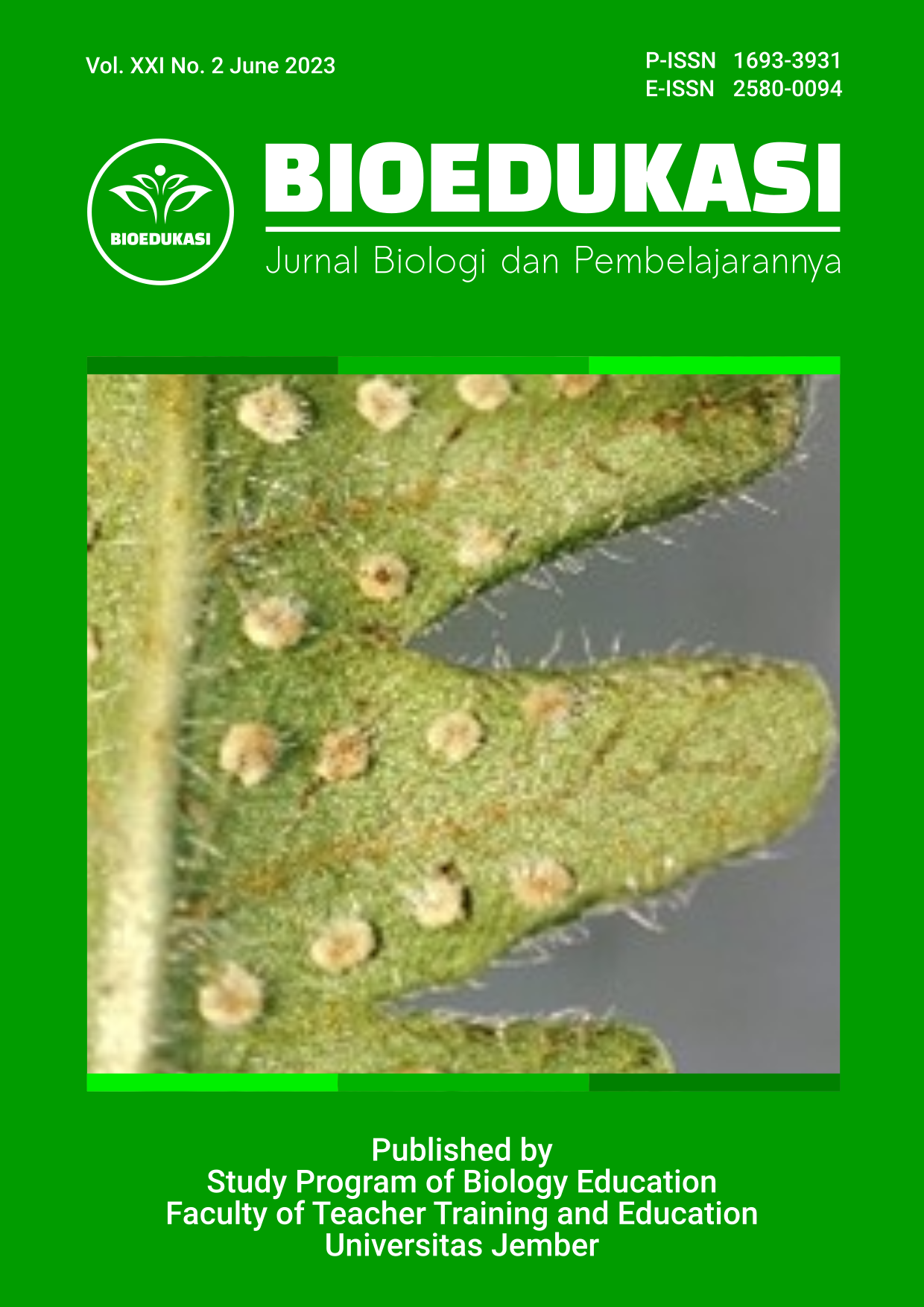A Development and Implementation of Integrated STEM-Based Science Textbooks and Local Potential of Coffee Agroecosystems to Improve Science Literacy for Junior High School Students
Abstract
The purpose of this research is to describe the characteristics of STEM-based teaching materials and to find out the increase in scientific literacy skills of junior high school students. The method used in this research is research and development. The design of this study uses the ADDIE model, with the stages of analysis, design, development, implementation, and evaluation. The trial design used the One Group Pretest-Posttest Design. The test subjects were class VII SMP Walisongo Mayang. The characteristics of this integrated STEM-based textbook and local potential contain material on temperature and heat, complemented by student environmental events as well as practicum procedures and project creation related to STEM aspects for students. The results of the validity of the textbooks developed by the validator show very valid criteria, with the results of the feasibility test using a student response questionnaire showing textbooks included in the practical category and good for students. As well as the results of the effectiveness of textbooks show that they can improve students' scientific literacy skills which are marked by an increase in pretest to posttest scores (t-test value 25,668 and n-gain 0.77). Developing textbooks for students makes it possible to develop them more broadly with STEM development as well as the problems and challenges faced by students in the surrounding environment.
References
Al Azri, R. H. & M. H Al-Rashdi. 2014. The Effect of Using Authentic Materials in Teaching. International Journal of Scientific & Technology Research. 3(10): 249-254. Tersedia di http://www.ijstr.org-print
Branch, Robert Maribe. 2009. Instructional Design: The ADDIE Approach.New York United States : Springer
BSNP. 2007.Peraturan menteri pendidikan nasional republik Indonesia nomor 41 tahun 2007 tentang Standar Proses untuk satuan pendidikan dasar dan menengah.Jakarta:Badan Standar Nasional Pendidikan
Daskolia, Maria,. Athnasios, Dimos., & Panaiotis. 2012. Secondary teachers’ conceptions of creative thinkingwithin the context of environmental education. International Journal of Enviromental & Science Education, 7 (2): 269-290 http://www.ijese.com/
Depdiknas. 2008. Panduan Pengembangan Bahan Ajar.Jakarta:Depdiknas
Direktorat Tenaga Kependidikan Direktorat Jenderal Peningkatan Mutu Pendidik Dan Tenaga Kependidikan Departemen Pendidikan Nasional. 2008. Penulisan Modul. https://teguhsasmitosdp1.files.wordpress.com.
Maeda, john.2013.STEM+Art=STEAM. The STEAM journal , Volume 1 Issue 1 Article 34. http://scholarship.claremont.edu/steam/vol1/iss1/34
Ginting, R. U. 2012. Efektivitas Penggunaan Bahan Ajar dan Belajar Mandiri dalam Rangka Peningkatan Hasil Belajar Termodinamika Dasar. Jurnal Pendidikan Teknologi dan Kejuruan Fakultas Teknik Unimed. 14(1): 1-6. Tersedia di https://digilib.unimed.ac.id
Guyotte., Kelly W., Sochacka, Nicola., Nadia. 2015. Collaborative Creativity in STEAM: Narratives of Art Education Student’s Experiences in Transdiciplinary Space. International Journal of Education & the Arts, 16 (15) : 1-38 http://www.ijea.org/v16n15/
Holbrook, J, dan Rannikmae, M. 2009. The Meaning of Science Literacy. International Journal of Environmental & Science Education. Vol. 4, No. 3: 275-288
Kurniawati, A. Ayu, Wahyuni, Sri, Putra, D. A Pramudya. 2017. Utilizing of Comic and Jember’s Local Wisdom as Integrated Science Learning Materials. International Journal of Social Science and Humanity, 7 (1) 47-50 doi: 10.18178/ijssh.2017.7.1.793.
Musfiroh, T dan Beniati, L. 2016. Kontruk Kompetensi Literasi Untuk Siswa Sekolah Dasar. Litera. Vol. 15 (1): 1-12.
OECD. 2018. PISA 2015. PISA Result in Focus. Paris: PISA-OECD Publishing.
Onosanya, S. A & E. O. Omosewo. 2011. Effect of Improvised and Standard Instructional Materials on Secondary School Students’ Academic Performance in Physics in Ilorin, Nigeria, Singapore. Journal of Scientific Research. 1(1): 68 – 76. Tersedia di http://scialert.net
Pratiwi, A, S. 2016. Penilaian Auntentik dalam Pengenalan Literasi Pada Pembelajaran Bahasa Indonesia di Sekolah Dasar. Naturalistic. Vol. 1 (1): 85-94.
Partnershipfor21stCenturySkills.2006.Frameworkfor21stcenturylearning.http://www.p21.org/documents/ProfDev.pdf
Roberts, A. 2012. A Justification for STEM Education. Technology and Engineering Teacher. 71(8): 1-4. Tersedia di https://www.iteea.org
Rehmat, A. P. 2015. Engineering the Path to Higher-Order Thinking in Elementary Education: A Problem-Based Learning Approach for STEM Integration. Disertasi. Las Vegas: University of Nevada. Tersedia di http://digitalscholarship.unlv.edu
Susanto, A. 2013. Teori Belajar Dan Pembelajaran di Sekolah Dasar. Jakarta: Prenadamedia.
Suyono & Hariyanto. 2015. Implementasi Belajar & Pembelajaran. Bandung:
Remaja Rosdakarya
Tarigan, H.G.1986.Analisis Buku ajar. Bandung: Angkasa
Tsupros, N., Kohler, R., & Hallinen, J. 2009. STEM education: A project to identify the missing components. Intermediate Unit 1: Center for STEM Education and Leonard Gelfand Center for Service Learning and Outreach, Carnegie Mellon University, Pennsylvania
Wahono, B., & Chang, C. 2018. Examining the relationship between science teachers' knowledge, attitude, and application of STEM education. International Conference of East-Asia Association for Science Education (EASE). 1-13
Wahono, B., & Chang, C. 2019. Assessing teacher’s attitude, knowledge, and application (AKA) on STEM: Aneffort to foster the sustainable development of STEM education. Sustainability, 11(4), 1–8. doi: https://doi.org/10.3390/su11040950
Yusuf, I. 2015. Peningkatan Aktivitas dan Hasil Belajar Fisika Melalui Pembelajaran Empece pada Siswa Kelas XI-IPA 4 SMA Negeri 5 Yogyakarta Tahun Pelajaran 2012/2013. Jurnal Ilmiah Guru Caraka Olah Pikir Edukatif. 19(1): 71-78. Tersedia di http://journal.uny.ac.id
Yuliati, D.I., D. Yulianti, & S. Khanafiyah. 2011. Pembelajaran Fisika Berbasis Hands on Activities untuk Menumbuhkan Kemampuan Berpikir Kritis dan Meningkatkan Hasil Belajar Siswa SMP. Jurnal Pendidikan Fisika Indonesia. 7: 23-27. Tersedia di https://journal.unnes.ac.id

This work is licensed under a Creative Commons Attribution-NonCommercial-NoDerivatives 4.0 International License.









 https://orcid.org/0000-0003-1920-0515
https://orcid.org/0000-0003-1920-0515
